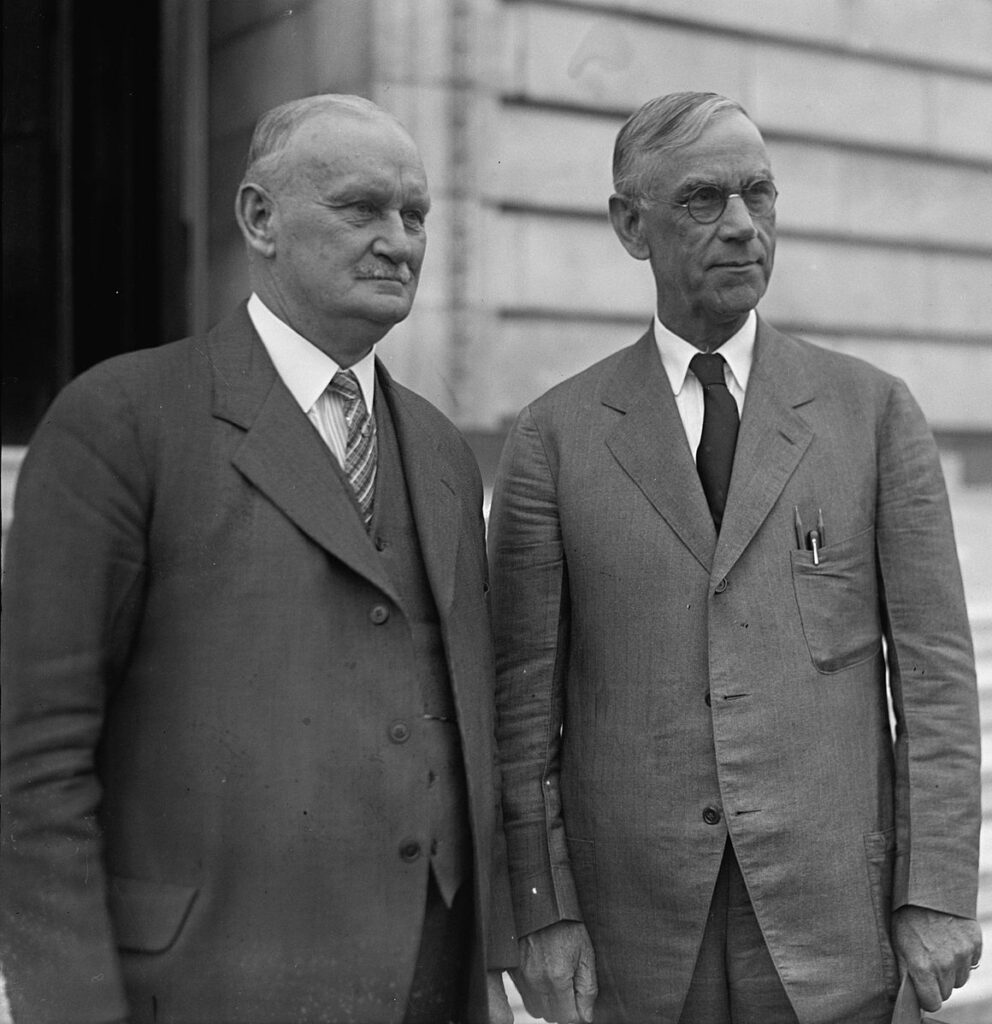Imagine it’s 1930. The U.S. economy is stumbling into the Great Depression, and in Washington, two lawmakers hatch a plan. Senator Reed Smoot and Representative Willis Hawley want to protect American jobs by raising taxes on foreign goods. They push through the Smoot-Hawley Tariff Act, hiking tariffs on over 20,000 imported products1. President Herbert Hoover signs it—against the advice of hundreds of economists—hoping higher import taxes will shield U.S. farmers and factories. But instead of an economic rescue, what followed was a global trade nightmare.

Willis C. Hawley (left) and Reed Smoot in 1929, shortly before the Smoot-Hawley Tariff Act1 became law. Their well-intended tariff hike triggered international retaliation and a collapse in global trade.
Smoot-Hawley’s unintended consequences were almost immediate. Other countries retaliated with tariffs of their own, and world trade plummeted by roughly 66%2 between 1929 and 1934. American exporters suddenly found foreign markets closing off. Even everyday goods got caught in the crossfire – for example, the U.S. tariff on eggs rose by 2 cents, but Canada hit back by quadrupling its tariff on American eggs, causing U.S. egg exports to Canada to collapse from almost a million dozen to just 13,000 dozen3. Prices of many goods rose, and the tariff that was meant to help ended up deepening the economic pain3. Smoot-Hawley didn’t cause the Great Depression, but it certainly made a bad situation worse. It has since become a classic cautionary tale in economics3 – a reminder that even well-intended trade policies can backfire spectacularly.
So why would anyone ever enact tariffs if they seem to spell nothing but disaster? The answer is—they don’t always. In fact, tariffs can sometimes lead to game-changing positive outcomes… or, at the very least, some unexpected ones.
As investors, our job isn’t to panic or play armchair policy wonk. It’s to sit back, watch the politicians play their game of grand strategy, and position our portfolios to capitalize on whatever opportunities come out the other side.
What Exactly Are Tariffs (and What They Aren’t)?
So, what is a tariff anyway? In simple terms, a tariff is a tax on imported goods3. Governments impose tariffs to make foreign products more expensive, ideally, so that consumers are more likely to buy domestic products instead. For example, if imported steel tomatoes or cars have a tariff, it adds to their cost when they enter the country. Tariffs can be a percentage of the item’s value (say 25% added to the price) or a flat fee per unit. The money usually goes to the government’s coffers as tax revenue.
It’s also useful to clarify what tariffs are not. A tariff isn’t an outright ban on a product (that would be an embargo or sanction). It’s not a quota or limit on quantity. And critically, a tariff is not paid by some foreign nation or exporter while locals reap the benefit. In reality, importers pay tariffs to their own government4, and they often pass those costs along. Studies show most of the cost of tariffs ends up being borne by consumers and businesses in the importing country through higher prices. In other words, tariffs are a tax on ourselves in practice, raising the price tag of foreign goods we buy. They can help local industries by making imported competitors pricier, but they can also hurt consumers (who pay more) and industries that rely on imported materials. Tariffs are not a one-sided free lunch; they shuffle money around (from importers/consumers to the government or protected industries) and can create a lot of economic distortion along the way.
What Exactly Are Tariffs?
Tariffs ARE:
A Tax on Imports
Tariffs are taxes placed on goods entering a country, making foreign products more expensive.
Government Revenue
The money collected from tariffs goes to the government's treasury as tax revenue.
Protection for Domestic Industries
By making imports more expensive, tariffs can help local producers compete.
Tariffs ARE NOT:
Not a Ban on Products
Unlike embargoes or sanctions, tariffs don't prohibit products - they just make them more expensive.
Not a Quota or Limit
Tariffs don't restrict the quantity of goods - just increase their price.
Not Paid by Foreign Countries
Importers pay tariffs to their own government, and costs are typically passed on to domestic consumers.
History’s Tariff Lessons
Believe it or not, one of the longest-lasting U.S. tariffs came out of a dispute over frozen chicken. In the early 1960s, European countries (notably West Germany) put tariffs on inexpensive U.S. chicken imports. President Lyndon Johnson retaliated in 1964 with a tax that would hit Europe where it hurt5 – he slapped a 25% tariff on imported light trucks (plus potato starch, dextrin, and brandy). This became known as the “Chicken Tax.”6 Originally aimed at Volkswagen vans and other foreign trucks, it survives to this day on pickup trucks and cargo vans.
The Chicken Tax had huge side effects. It essentially shut most foreign pickup trucks out of the U.S. market6 , protecting Detroit’s Big Three automakers from import competition. Foreign companies like Toyota, Nissan, and others responded by building truck factories in the U.S. (to avoid the tariff) or finding loopholes. As a result, thousands of American jobs were created and foreign companies deepened their American market presence. For investors who recognized this trend, the opportunity wasn’t in short-term trade restrictions but in the long-term transformation of American manufacturing.
As we can see, tariffs can have unintended but positive consequences!
Modern Trade Tensions: Chips, EVs, and Solar Panels
Tariffs aren’t only historical footnotes; they’re front and center in today’s headlines – though sometimes in new forms. In recent years, trade frictions have evolved beyond simple import taxes on goods like steel or aluminum. We’re now seeing strategic tariffs and export restrictions in high-tech sectors and renewable energy, often justified by national security or industrial policy concerns.
For example, the ongoing U.S.-China “chip war.” Instead of a traditional tariff on a consumer good, the U.S. government has imposed export controls on advanced semiconductors and the equipment used to make them. Essentially, U.S. firms are restricted from selling cutting-edge chips and machinery to Chinese companies. This is meant to protect U.S. technological advantage and national security. China, for its part, has responded with its own measures (like limiting exports of certain rare minerals critical to chip production).
For investors, these moves create a complex mix of risks and opportunities: an American chip maker like Nvidia might lose some sales to China due to export controls, but at the same time, domestic chip fabrication plants (and their suppliers) might benefit from huge government investments and a more captive market. It’s a form of de facto trade barrier in tech – not a tariff at the border, but a regulation achieving a similar effect of reshuffling who can trade with whom. The result is higher costs (building redundant chip factories in multiple countries is expensive) and uncertainty for any company caught in the middle of U.S.-China tech tensions.
Policy Mechanism
Export Controls
U.S. restricts sales of advanced chips and manufacturing equipment to Chinese companies
Not a traditional tariff but achieves similar trade barrier effects
Trade Flow Impact
Winners & Losers
Winners
- Domestic chip fabrication plants
- Allied country chip makers
- Semiconductor equipment makers with U.S. government contracts
Losers
- U.S. chip makers losing Chinese sales
- Consumer electronics with higher costs
- Global supply chain efficiency
Policy Mechanism
100% Tariff on Chinese EVs
U.S. doubled the price of imported Chinese electric vehicles
Combined with domestic subsidies for North American-made EVs
Price Impact
Tariff
Winners & Losers
Winners
- U.S. and allied EV manufacturers
- North American battery producers
- Domestic supply chain companies
Losers
- U.S. consumers (fewer choices, higher prices)
- Chinese EV makers
- Global climate goals (potentially slower EV adoption)
Policy Mechanism
50% Tariff on Chinese Solar Cells
U.S. significantly increases cost of imported Chinese solar components
Part of broader clean tech protectionism to develop domestic manufacturing
Supply Chain Shift
Before Tariffs
After Tariffs
Winners & Losers
Winners
- U.S. solar manufacturers
- Non-Chinese foreign producers
- Domestic installation companies (eventually)
Losers
- Solar project developers (short-term)
- U.S. consumers (higher costs)
- Chinese manufacturers
Key Takeaway
Modern trade tensions are reshaping global supply chains and creating a more fragmented world economy - with significant implications for investors.
Another hot area is electric vehicles (EVs) and solar panels. These are industries of the future, and governments are keen to nurture their own champions. The U.S. has used a mix of subsidies for domestic production (like tax credits for EVs made in North America) and tariffs on imports. In fact, as of late 2024, the U.S. Trade Representative finalized steep tariffs targeting Chinese clean-tech imports – including a 100% tariff on imported electric vehicles and a 50% tariff on imported solar cells7.
Those numbers are eye-popping. A 100% tariff can double the price of a foreign EV, essentially pricing it out of the market. The rationale is to protect U.S. and allied EV manufacturers from a flood of cheaper Chinese models8 and to encourage local battery supply chains. Europe is doing something similar: the EU has approved tariffs (in the range of ~10% to possibly as high as 45%) on Chinese-made EVs amid fears that European carmakers are threatened.
The key point is that modern tariffs and trade barriers are often entangled with politics and big-picture trends. They create winners and losers. They can also make the world less flat: supply chains that used to sprawl globally might shorten, and companies might shift production to dodge tariffs, such as Japanese automakers.
Tariffs, Prices, and Market Jitters
From an investor’s standpoint, why do tariffs matter so much? The short answer is that tariffs can move markets because they can affect corporate profits, consumer prices, and overall economic growth. When tariffs are announced or threatened, you’ll often see the stock market react quickly. Investors dislike uncertainty, and a new tariff can introduce a lot of uncertainty. Will costs go up for a company? Will sales abroad go down? Will supply chains get disrupted? These are the questions that start swirling.
As we’ve all seen this year, tariff news causes noticeable swings in stock indices9. Beyond the April shakeup, in March, we saw U.S. stocks fall into a correction (a drop of 10% or more) as tariff announcements piled up.
However, if we take a step back and look at the bigger picture, we can see that even during some of the hottest trade wars, markets continue their onward march up and to the right.
| Trade Event | Years | Industries Affected | Avg. S&P 500 Return |
|---|---|---|---|
| The “Chicken War” | 1961–64 | Poultry, Automobiles, Starch | 10.80%* |
| Japanese Auto Quotas | 1981–84 | Automobiles | 11.37% |
| Softwood Lumber Dispute | 1982–83 | Construction Materials | 22.06% |
| The “Pasta War” | 1985 | Food Products, Agriculture | 31.73% |
| The “Banana Wars” | 1993–99 | Agriculture, Import/Export | 22.13% |
| Bush Steel Tariffs | 2002–03 | Steel, Manufacturing | 3.29% |
* For 1961–64, only “Change in Index” data is available (no total return incl. dividends). Source: https://en.wikipedia.org/wiki/S%26P_500
The key in all of this is to stay the course, not chase headlines. Tariffs come and go, but sound strategy endures. Broad diversification remains one of the best defenses against geopolitical shocks—whether it’s trade disputes, interest rate swings, or supply chain hiccups. And within that framework, there are often new opportunities hiding in plain sight. Companies that adapt quickly—by retooling supply chains, reshoring production, or capitalizing on policy shifts—tend to gain market share over time. That’s where long-term focus pays off. The goal isn’t to outguess the next round of tariffs—it’s to build a portfolio that thrives no matter what the politicians are doing this quarter.
Conclusion: Keeping Your Plans in Sync
in a Changing World
Tariffs and trade policies will likely continue to ebb and flow with political winds. We’ve seen how something as arcane as a tariff code can reverberate from factories to financial markets. The big takeaway for an investor is that change is the only constant – whether it’s changes in trade rules, technology, or consumer habits. You can’t predict every twist, but you can prepare.
Before we wrap up, here’s something to consider: Are you confident that your business plans, investment portfolio, estate plan, and retirement goals are all aligned and resilient in the face of economic changes? If not, it may be time to sit down with a qualified financial planner.
At WealthGen Advisors, we specialize in helping business owners and professionals integrate these moving parts into a coherent strategy. The world will keep throwing curveballs – be it tariffs, inflation, or something totally unexpected – but with an aligned plan, you’ll be in a much stronger position to adapt and thrive. Click the button below to arrange a consultation, and we look forward to speaking with you.
Sources:
- https://en.wikipedia.org/wiki/Smoot%E2%80%93Hawley_Tariff_Act
- https://history.state.gov/milestones/1921-1936/protectionism
- https://www.npr.org/2024/12/20/nx-s1-5223409/with-trump-proposing-new-tariffs-we-look-at-a-cautionary-tale-from-u-s-history
- https://www.cfr.org/backgrounder/what-are-tariffs
- https://www.npr.org/sections/money/2017/01/25/511663527/episode-632-the-chicken-tax
- https://en.wikipedia.org/wiki/Chicken_tax
- https://www.utilitydive.com/news/joe-biden-china-tariff-hikes-ev-battery-semiconductor-final/727014/
- https://www.csis.org/blogs/trustee-china-hand/slamming-brakes-eu-votes-impose-tariffs-chinese-evs
- https://www.reuters.com/markets/us/investors-flee-equities-trump-driven-uncertainty-sparks-economic-worry-2025-03-10/
Disclosures
Different types of investments involve varying degrees of risk, and there can be no assurance that any specific investment or strategy will be suitable or profitable for a client’s portfolio. All investment strategies have the potential for profit or loss. Information presented is believed to be factual and up-to-date, but we do not guarantee its accuracy and it should not be regarded as a complete analysis of the subjects discussed. All expressions of opinion reflect the judgment of the author/presenter as of the date of publication and are subject to change and do not constitute personalized investment advice.
A professional advisor should be consulted before implementing any investment strategy. WealthGen Advisors does not represent, warranty, or imply that the services or methods of analysis employed by the Firm can or will predict future results, successfully identify market tops or bottoms, or insulate clients from losses due to market corrections or declines. Investments are subject to market risks and potential loss of principal invested, and all investment strategies likewise have the potential for profit or loss. Past performance is no guarantee of future results.
Please note: While we strive to provide accurate and helpful information, we are not Certified Public Accountants (CPAs). The information in this article is intended for informational and educational purposes only and should not be interpreted as tax advice. It is crucial to consult with a CPA, tax professional or estate attorney to discuss your personal situation.
Author
-

A Florida native, and full-time Sarasota resident, Ken founded WealthGen Advisors, LLC after spending more than fourteen years in the financial advisory industry. Ken holds multiple industry designations, as well as a master's degree in Financial Planning. Prior to founding WealthGen Advisors, Ken spent almost a decade in New York and then Texas as Vice President at The Capital Group, a $2T global investment manager serving institutional clients and pension funds.
View all posts











